

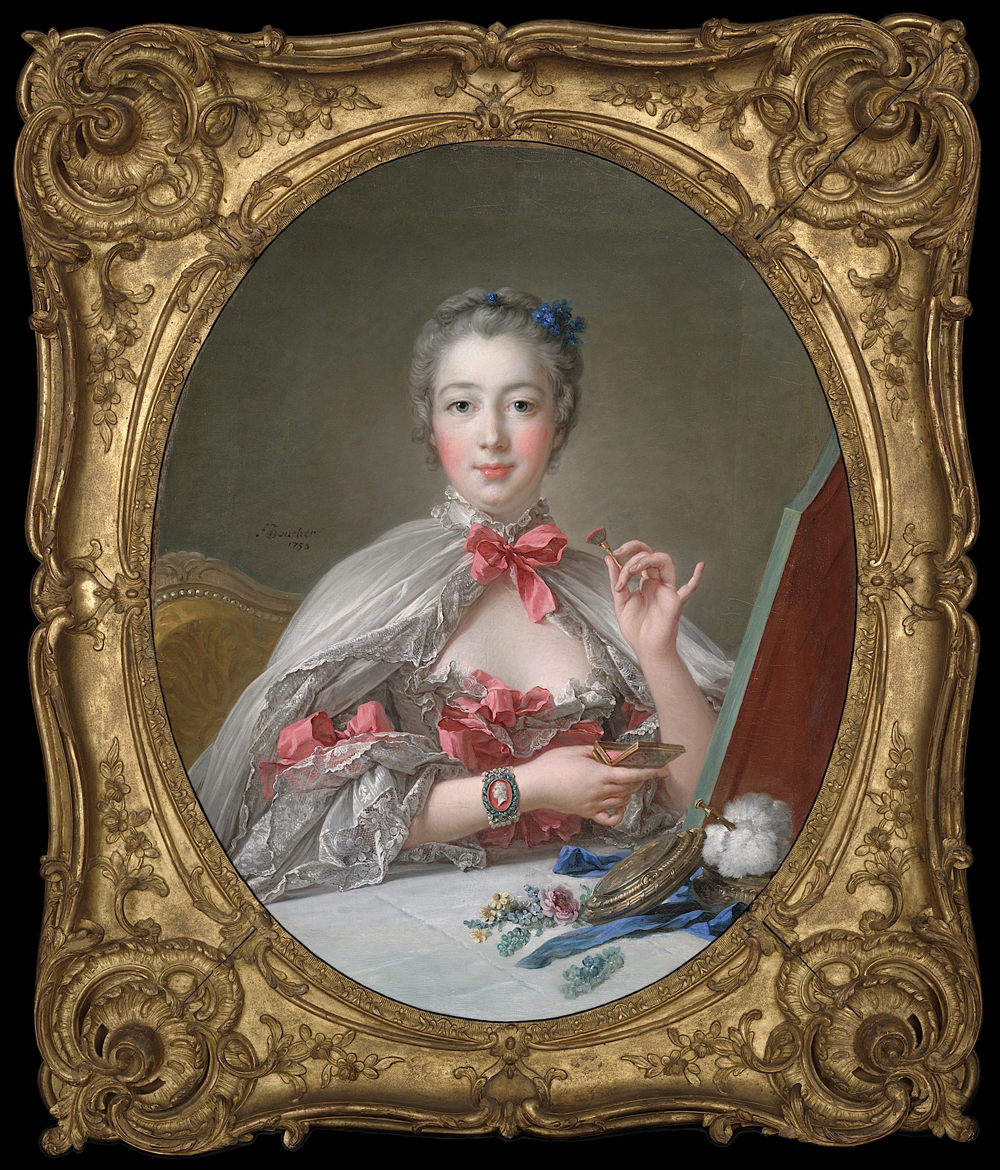
| On the previous page we were looking at Madame de Pompadour's engravings in her Suite d'estampes gravees par Madame la marquise de Pompadour d'apres les pierres gravees de Guay, graveur du roy. The Walters Art Museum has a digitized copy that you can view, (see this page). I soon became fascinated with this, and found an article that mentions the person who rediscovered this Walters copy, a Columbia University art historian Susan Wager. |
|
"Not long ago, Wager discovered a leather portfolio containing etchings made by Pompadour. For over a century, the portfolio and its etchings had gone unrecognized. Wager discovered it at the Walters Art Museum in Baltimore, Md., among a batch of items founder Henry Walters bought in 1895.
"I was so thrilled," she recalls. "When I pulled that out of the box in the manuscripts room, my heart started to pound. I could barely talk."
There were 52 etchings in all. Pompadour made fewer than 20 copies of them and gave them as gifts. She put her own set in a lemon-yellow leather portfolio, the one that Wager found.
"It has this gorgeous, gold embossed coat of arms at the center and all this gold lacework," Wager says.
Wager did some Nancy Drew sleuthing with this portfolio: She knows it was Pompadour's personal set because it's printed on different paper than the other surviving sets (indicating it was a first-run printer's proof). There's also a hand-written table of contents inside, no other surviving set has that list. |
| This idea that the Walters example is Madame Pompadour's own personal set is quite interesting, certainly the page layout is not the same as that we see in the BnF example, I started looking for all the examples of individual plates that can be found online, and there are many. There were a number of things I wanted to clear up, firstly is the date that these complete sets were made. The Walters copy thought to be a first printing contains plates that have dates on them, dates that mean that the Douceur binding could not have been made 1755 (the date given for it by the Walters experts). For example, plate 56, shown below was created to commemorate the battle of Lutterberg. "The Battle of Lutterberg took place on 10 October 1758 during the Seven Years' War between a French force of 42,000 commanded by Charles, Prince of Soubise and a much smaller Anglo-German force commanded by General Christoph Ludwig von Oberg." I suspect that this engraving by Madame Pompadour was not made immediately after this battle and as it is plate 56, that it may have been made before plate 63 which is the last plate in the folder, then when everything is printed and collated they can ask Douceur to make this splendid binding. I am thinking that it would be at the earliest, 1759. It may be that Pompadour was able to print these plates herself as we know she had her own printing press. "that she made engravings herself and even had a printing press transferred one day from the Imprimerie Royale to her apartment at Versailles." |


| The more I searched the more I was determined to find out when exactly the Bnf Pompadour engravings were made. Derome's binding was telling me that there is no way that it was made in 1775. I searched for hours to find some proof of a 1775 edition, the World Cat shows one but its link is back to the BnF, this means that the BnF was promoting such an edition, but where else was the proof. Then I found a reference in the 1882 Repertoire general et methodique de la Librairie Morgand et Fatout issued in Paris by the firm of Damascne Morgand and Charles Fatout... who are they you ask... "Volume I of the Bulletin (1876-78), containing the first 8 issues describing a total of 4562 priced items continuously numbered, followed by an elaborate index of authors and anonymous works found in the first volume. According to Roland Folter, the lot numbering continued in 9 subsequent volumes of the Bulletin, comprising 59 issues in 10 volumes (1876-1904), describing 46,593 lots on well over 10,000 pages with 91 plates (19 in color) and over 600 text illustrations, making it perhaps the most voluminous antiquarian bookseller's catalogue ever published". In their 1882 catalogue we find two examples of Pompadour's Suite d'estampes gravees par Madame la marquise de Pompadour d'apres les pierres gravees de Guay, graveur du roy. they discuss both editions the first and the 1782 edition in detail (shown Below) there is no mention whatsoever of a 1775 edition. Searching further I finally found something that had been on my mind since the beginning, that was if another set was printed, who printed it and why do we not find a reference to it. What I discovered was that Madame Pomadour bequeathed her belongings to her brother, he died in 1781 and his belongings were auctioned off in 1782, Pompadour's original engraved copper plates for the Suite d'estampes..., turned up in that auction and were bought by a certain Basan (Basan, Pierre-Franois (1723-1797) for 531 livres and that same year Prault produced the 1782 edition. This then ends the story of the 1775 edition unless it was printed by Madame Pompadour's brother, and if it was I doubt whether this fact would remain a secret for long. I was thinking that I should start a separate page here entitled "INVENTIONS FABRICATIONS AND ERRORS BY 'EXPERTS'. Here again the BnF have messed up, there is no 1775 edition, and so these plates that they show on Gallica are some of the original plates possibly printed by Madame Pompadour herself, perhaps printed in 1759. However oddly enough the BnF error quite possibly derives from an earlier Morgand et Fatout Bulletin of 1878. I show it below under the 1882 Repertoire. |

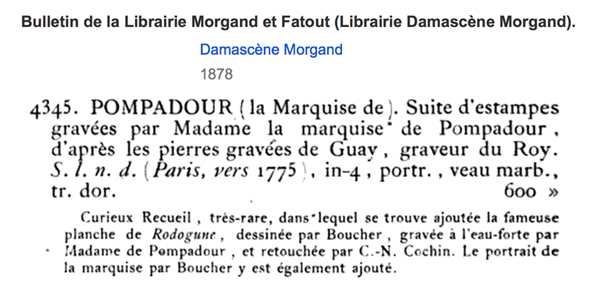
| Finally I found the definitive book on all this Notice sur Jacques Guay: graveur sur pierres fines du roi Louis XV by Jean Franois Leturcq, printed by Librairie de J. Baur, 1873, this entire work can be viewed online at Archive.org (click here to see it). I see now that I am opening a huge can of worms, below is a page from Leturcq where he mentions a letter written by the brother of Madame de Pompadour Abel-Franois Poisson de Vandires, marquis de Marigny and marquis de Menars (1727 Ð 12 May 1781), often referred to simply as marquis de Marigny, possibly around 1777 to the Baron Joursanvault, where he explains the occurance of extra plates in a copy of the Suite d'estampes... that he was sending to him. No where does he say that he was printing them. Is this the source of the 1775 edition...? it turns out that in the BnF copy is found a letter that they have included in the Gallica online copy, that letter does not mention anything about 1775 but it does mention this very letter of marquis de Marigny. |
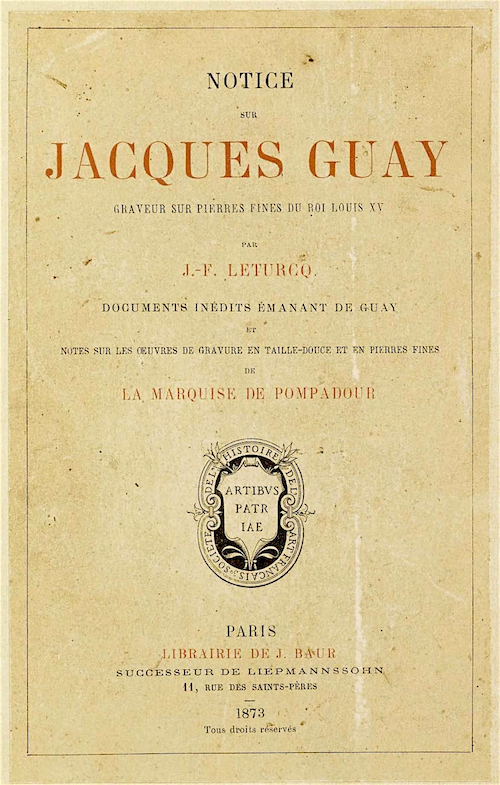
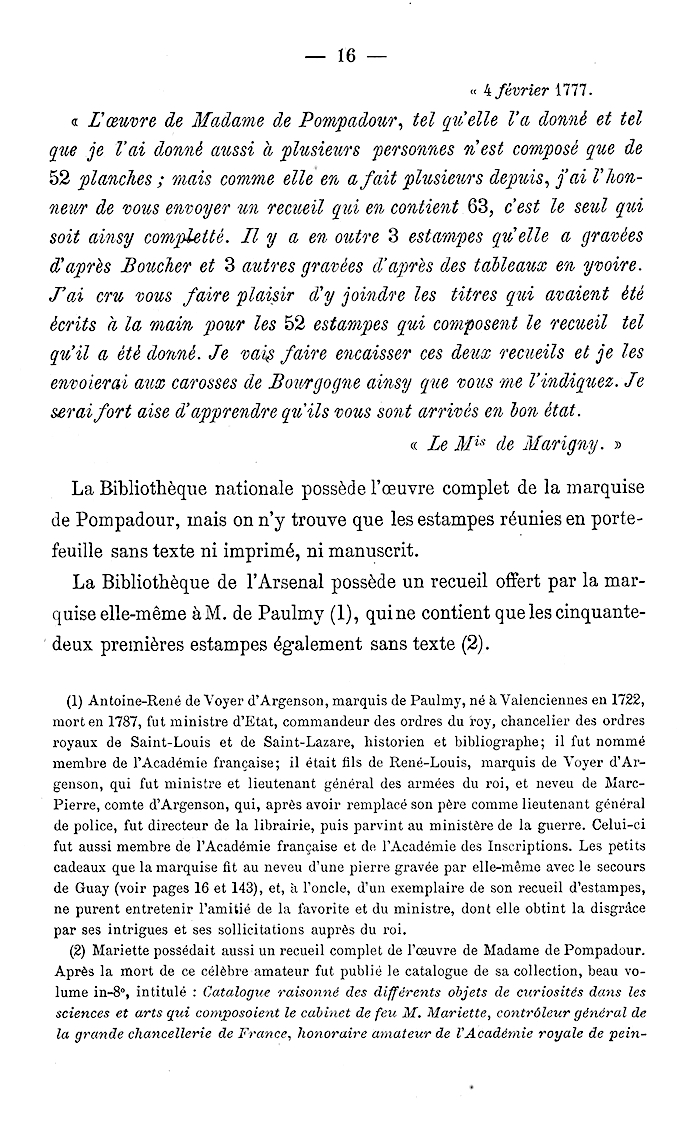
|
Now if there was another edition of the Suite d'estampes... then it had to have been made by the marquis de Marigny, Madame de Pompadour's brother, he inherited the plates, and IF it is this, the 1775 edition, that he gave to the Baron Joursanvault in 1777, we must first imagine that the Marquis would spend his time printing up new copies of his sisters engravings. This seems to me a bit out of the realm of likely, when you see just what kind of life he was living. Madame de Pompadour left to him, her Palace the Chateau de Menars! its beyond imaging this enormous gift, left to him by the most powerful woman of the eighteenth century. And we can see that it kept him very busy, which I think is great credit to him, he made the Chateau even more magnificent and something his sister would have been even more proud of, obviously she left it to the right person. Below is a list of what was keeping him busy...
"With the death of the marquise de Pompadour in 1764, the chateau passed to her brother, Abel-Franois Poisson de Vandires, marquis de Marigny, and general director of the Batiments du Roi. Some new work was then realized under the direction of architect Jacques-Germain Soufflot: the side court, and the main building were doubled and the ground floor covered a l'italienne, while the wings built by Gabriel were equipped with pitched slate roofs a la francaise. During Marigny's tenure an English garden was created in the Bois-Bas, with a small ravine located to the west, in which Marigny planted thickets of various diverse trees, sheltering cabinets of trellis-work. One of them contained a famous hydraulic machine, conceived by the mechanic Loriot. At the edge of the Loire, a Desert was arranged in an old sand pit and was decorated as an artificial grotto. Marigny devoted all his care to the installation of the park for the presentation of its prestigious collection of sculpture. In front of the chateau, in place of the former parterres, he created a broad terrace. He remade the gardens in the style of his day while commissioning many garden follies. At the foot of the chateau, the "Rotunda of Abundance", built by Soufflot, permits passage from the basement of the chateau to the interior of the orangery. Towards the east, the terrace ends in a roundabout where Marigny built a kiosk in the Chinese manner designed by Charles De Wailly. Between the terrace and the road, are ordered a series of hedges, trellises, outdoor rooms of greenery as well as a kitchen garden. Below, around a small fountain, Soufflot created a magnificent nymphaeum with Serlian windows on the facade and, inside, the use of the Doric order reveals an Italianate inspiration." |
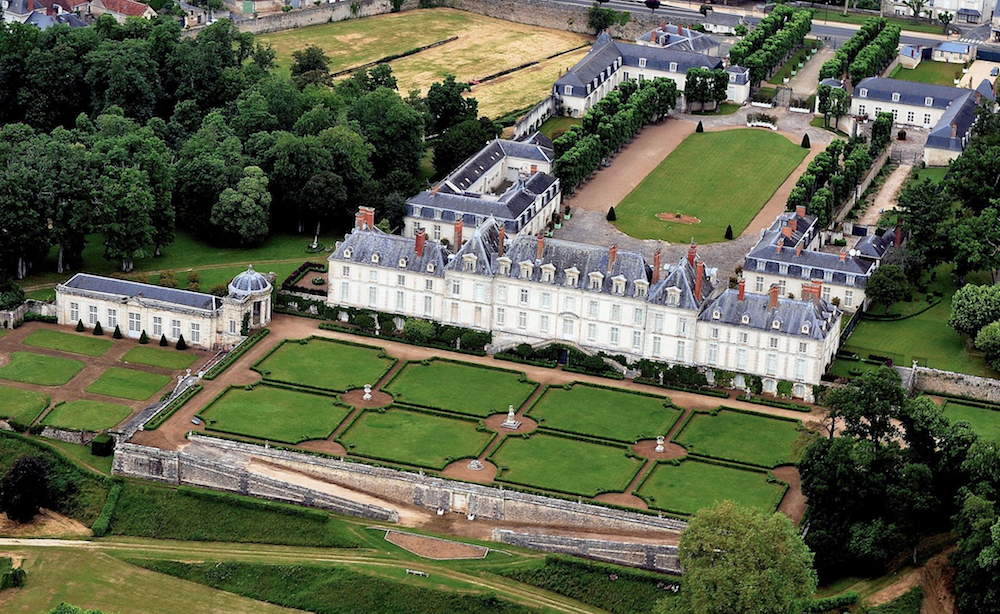
|
After all he was directeur general des Batiments du Roi (director general of the King's Buildings). He kept this position until his retirement in 1773, thereby setting a record for the longest administrative service in the 18th century in France. and the Chateau de Menars was not his only residence! 1752-1778: Hotel de Marigny, built in 1640, rue Saint-Thomas-du-Louvre (demolished, the site today is the corner of the Richelieu wing of the Louvre and the north-east corner of the "pyramide du Louvre"). The Direction generale des Batiments was located there until 1773. 1778-1781: Hotel de Massiac, Place des Victoires, built in 1635. 1754-1781: Chateau of Marigny-en-Orxois, a renovated medieval castle. 1759-1773: Hotel de Marigny, faubourg du Roule, Paris. Bought from Louis Philippe I, Duke of Orleans. Redesigned in 1768-1771 by Jacques-Germain Soufflot who constructed the western faade in a Palladian style. 1764-1781: Chateau de Menars in Menars (Loir-et-Cher), inherited from his sister, the marquise de Pompadour. Pavillon Le Pate in Bercy, south-east of Paris, built in 1720. 1781: Hotel Delpech de Chaumot, n¡ 8 Place Vendome in Paris. I may be wrong but somehow I don't see Marigny running short of money, unfortunately he died suddenly in 1781 without leaving a will. Now I ask you, do you think he had time to print up this famous 1775 edition? And I say famous because the BnF in colaboration with Hachette Livre published their own 1775 edition that you can still buy on Amazon (click here to see this you won't believe it), Suite d'estampes gravees par Madame la marquise de Pompadour d'apres les pierres gravees de Guay, graveur du Roy Date de l'edition originale: 1775 Mecenat texte imprime Cet ouvrage a ete numerise grace a Clara Fougerol Ce livre est la reproduction fidele d'une oeuvre publiee avant 1920 et fait partie d'une collection de livres reimprimes a la demande editee par Hachette Livre, dans le cadre d'un partenariat avec la Bibliotheque nationale de France, offrant l'opportunite d'acceder a des ouvrages anciens et souvent rares issus des fonds patrimoniaux de la BnF. Les oeuvres faisant partie de cette collection ont ete numerisees par la BnF et sont presentes sur Gallica, sa bibliotheque numerique. |
|
click here to return to the HOME page. click here to see the INDEX of the 2017 pages. see below links to previous work |
| Even experts are sometimes wrong, before you spend thousands on a book, please do your own research! Just because I say a certain binding can be attributed to le Maitre isn't any kind of guarantee, don't take my word for it, go a step further and get your own proof. In these pages I have provided you with a way of doing just that. |
| Virtual Bookings, created by L. A. Miller | return to the Home page of VIRTUAL BOOKBINDINGS |